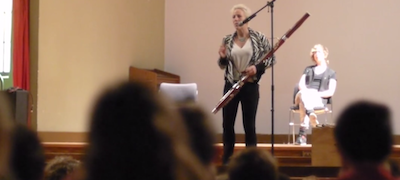ICE education has been literally all over the map this fall! In a few days, I’ll post about our workshops in Morelia, Mexico during our appearance at that city’s music festival over Thanksgiving. And this weekend, ICE starts our inaugural residency with Youth Orchestra L.A., the education arm of the Los Angeles Philharmonic.
In October, ICE began a special year-long residency at the Lycée Français de Chicago, a distinguished international K-12 school in the North Lakeview neighborhood. Our first events were two all-school assemblies, introducing the students to myself, Claire, and Rebekah, and featuring lots of extended playing techniques, wild repertoire, and crowdsourced improvising.
ICE’s project at the Lycée is inspired by the great French-American composer Edgard Varèse, whose complete works ICE presented at the Lincoln Center Festival in 2010, with Sō Percussion and Steven Schick. Varèse’s pathbreaking piece Poème Électronique, written for the 1958 Brussels World’s Fair, was one of the first pieces written purely for tape, and, originally, one of the first multimedia presentations with music; it was housed in a structure designed by the great architectural firm of Le Corbusier, and supervised by the architect and composer Iannis Xenakis (another ICE favorite). During the six months of the fair, millions of people heard the piece as they walked through the structure, and were simultaneously treated to a light show with projections depicting the history of civilization.












